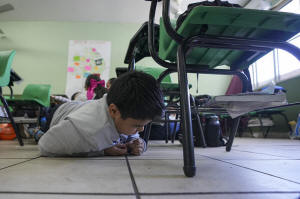Cartel-plagued Mexican city pins hopes on Trump's anti-drug trafficking
pressure
[March 03, 2025]
By MARÍA VERZA
CULIACAN, Mexico (AP) — Before dawn, an elementary school principal in
the capital of Mexico's Sinaloa state checks various chats on his phone
for word of shootouts or other incidents. If there’s danger, he sends a
message to his students’ parents suspending classes.
It isn’t the only new routine in Culiacan, a city of 1 million residents
that for the past six months has been the battlefield for the two main
factions of the Sinaloa drug cartel.
The violence has limited the hours to bury the dead. Bands that played
big parties now play for money at intersections. Any loud noise sends
children scurrying for cover. And those who live on the shifting front
lines fear for their lives daily.
This is the first extended period of violence that has touched
Culiacan's residents because there was safety in the cartel’s total
domination. Now, many residents are grateful for the pressure applied by
U.S. President Donald Trump to get Mexico to go after the cartels and
some are optimistic that this difficult period could change the
persistent view that the cartel has been their protector.
‘Tired of being among the bullets’
It started in September, more than a month after Ismael “El Mayo”
Zambada — the Sinaloa cartel's oldest and most astute leader — says he
was kidnapped by one of the sons of former leader Joaquín “El Chapo”
Guzmán and taken to the U.S. where they were both arrested.
It unleashed a power struggle between both cartel factions and the
unwritten agreement to not attack residents uninvolved in the drug trade
was broken.

There were carjackings, kidnappings, innocents caught in crossfires and
cartel roadblocks where gunmen would scan people’s cell phones looking
for any trace of contact with the other side. According to government
data, there have been more than 900 killings since September.
A resident of Costa Rica, a small town south of the capital, traced the
front line on the horizon: on one side the “Chapos,” on the other the “Mayos.”
He, like most others, requested anonymity because of the danger.
An old man there said he saw gunmen dump two bodies in the street.
And sometimes people just disappear. Julio Héctor Carrillo, 34, never
arrived home from visiting a relative in late January. According to his
brother-in-law, Mario Beltrán, his only transgression was not respecting
the locals' self-imposed curfew.
His family didn’t dare to put up signs for their search, instead
sticking to social platforms. A search collective looking for the
disappeared found a body that is undergoing DNA testing.
“At no other time in the last 30 to 40 years that we have crime stats,
have we had so many families with disappeared (relatives),” said Miguel
Calderón of the State Public Security Council, a citizen organization.
Some are simply picked up, interrogated and released, but others end up
on the wall of faces at Culiacan’s cathedral.
“Truly, we’re very tired, very tired of being among the bullets,” said a
38-year-old small business owner who has imposed his own family security
protocol: no cycling for their 18-year-old son, who they take
everywhere, including to visit his girlfriend, and track in real time
through his cell phone.
Their 7-year-old daughter asks in the morning: “‘Dad, am I going to be
able to go to school today? Did you already check (Facebook)?’”

“There are things you can’t hide from children,” he said.
U.S.: The solution or the problem?
How Mexican authorities are addressing the violence has changed notably
in the past month and locals believe Trump is the reason.
When it started, Mexico was led by President Andrés Manuel López Obrador,
who minimized cartel violence and expressed no interest in going after
cartel leaders. His close ally, Sinaloa Gov. Rubén Rocha did the same.
Rocha’s spokesman, Feliciano Castro, maintains that the U.S. set off the
violence by arresting Zambada.
[to top of second column]
|

A student participates in an active shooter drill at the Socrates
elementary school in Culiacan, Mexico, Thursday, Feb. 27, 2025. (AP
Photo/Fernando Llano)

Things changed when Trump won the election. Shutting down illegal
immigration and going after drug traffickers were among his campaign
promises and he's threatened to impose 25% tariffs Tuesday. Mexico’s
new President Claudia Sheinbaum had already shown herself willing to
take a more aggressive hand with the cartels, especially Sinaloa,
whose main business is fentanyl.
The number of security operations and arrests in Sinaloa have
multiplied and now there is direct federal supervision of all
security action.
“We have never seen such an overwhelming and daily operation against
the cartels,” said Ismael Bojórquez, a veteran Sinaloa journalist
covering organized crime, who was critical of López Obrador’s
hands-off approach.
In December, authorities seized more than a ton of fentanyl in
Sinaloa compared to just 286 pounds in all of Mexico in the first
six months of 2024.
In the last 10 days of February, authorities dismantled 113
synthetic drug labs, according to preliminary state data.
Authorities have not clarified if they produced fentanyl or
methamphetamine. It’s unknown what, if any, role U.S. intelligence
played.
In Culiacan, authorities took down more than 400 cartel surveillance
cameras, double what authorities had.
The recent actions have weakened both cartel factions but the
government can’t let up if it really wants to decimate them,
Bojórquez said.
“I never thought (Trump) would have so much power to do that … but
I’m grateful,” said the owner of a beer store stopped at a police
checkpoint.
A 55-year-old woman sitting on a bench watching a forensics team
load a murder victim's body into a truck agreed. The day before, she
had attended a Mass for her son-in-law who was killed five months
earlier by a stray bullet while he was walking with his daughter a
few blocks away.
"We leave home but we don’t know if we’ll return,” she said.
Overcome fear, build peace
In the halls of Socrates Elementary school in downtown Culiacan,
signs explain what to do in case of a shootout and children drill
suddenly dropping to the ground when the alarm sounds.

Principal Victor Manuel Aispuro says he can't remember what it was
like to have all of his nearly 400 students in school. Some 80
families fled the city and there were days when no more than 10 kids
attended. He decides each day if there will be in-person classes.
The last time he closed was late last month when intense firefights
and low-flying helicopters panicked residents. Two key cartel
members were arrested.
In January, one of his students, a 9-year-old boy, was killed along
with his 12-year-old brother and their father in a carjacking.
Thousands of residents took to the streets in a rare public display
of indignation.
At a workshop, a nongovernmental organization of ex-police led
students through an exercise writing down what scares them. One
listed spiders, gun shots and white trucks (the preferred cartel
transportation). Another said he’s afraid of being extorted or
killed.
“The people are full of a sense of collective anguish, anxiety,
social anger and that’s different from other crises,” said Calderón,
the coordinator of the citizen security group. He said he hopes it
could dissolve the complicity of citizens, who for years saw the
cartel as protectors, heroes or figures to emulate.
All contents © copyright 2025 Associated Press. All rights reserved |